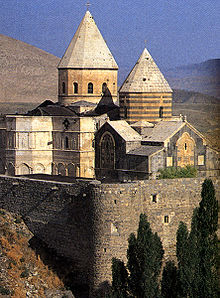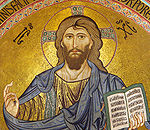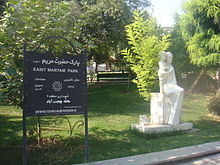- Christianity in Iran
-
Christianity by Country
North AmericaSouth AmericaOceaniaChristianity in Iran has a long history, dating back to the early years of the faith. It has always been a minority religion, with the majority state religions — Zoroastrianism before the Islamic conquest, Sunni Islam in the Middle Ages and Shia Islam in modern times — though it had a much larger representation in the past than it does today. Christians of Iran have played a significant part in the history of Christian mission. Today, there are at least 600 churches in Iran.[1]
Contents
Main denominations
A number of Christian denominations are represented in Iran. Many members of the larger, older churches belong to ethnic groups with their own distinctive culture and language. The members of the newer, smaller churches are drawn both from the traditionally Christian ethnic minorities and to an increasingly larger degree converts from non-Christian background.
The main Christian churches are:
- Armenian Apostolic Church of Iran (between 110,000[2] and 250,000 adherents[3])
- Assyrian Church of the East of Iran (about 11,000 adherents),[4]
- Chaldean Catholic Church of Iran (about 7,000 adherents),[4]
- various other denominations, some examples are:
- Presbyterian, including the Assyrian Evangelical Church
- Pentecostal, including the Assyrian Pentecostal Church
- Jama'at-e Rabbani (the Iranian Assemblies of God churches)
- and the Anglican Church of Iran.
According to Operation World, there are between 7,000 and 15,000 members and adherents of the various Protestant, Evangelical and other minority churches in Iran,[4] though these numbers are particularly difficult to verify under the current political circumstances.[citation needed]
The International Religious Freedom Report 2004 by the U.S. State Department quotes a somewhat higher total number of 300,000 Christians in Iran, and states the majority of whom are ethnic Armenians.[5]
Iranian government sources are sometimes quoted as giving a total of as many as 300,000 Christians in Iran. At present there are 73 registered churches in Iran.[6]
History
 Qara Kelissa, West Azarbaijan. Believed by some to have been first built in 66 AD by Saint Jude. Local Armenians believe that he and Simon were both buried here. In 1329, the church was reconstructed after an earthquake destroyed the structure in 1319.
Qara Kelissa, West Azarbaijan. Believed by some to have been first built in 66 AD by Saint Jude. Local Armenians believe that he and Simon were both buried here. In 1329, the church was reconstructed after an earthquake destroyed the structure in 1319.
According to Acts 2:9 in the Acts of the Apostles there were Persians, Parthians and Medes among the very first new Christian converts at Pentecost. Since then there has been a continuous presence of Christians in Persia/Iran.
During the apostolic age, Christianity began to establish itself throughout the Mediterranean. However, a quite different Christian culture developed on the eastern borders of the Roman Empire and in Persia. Syriac Christianity owed much to preexistent Jewish communities and the Aramaic language. This language was most probably spoken by Jesus, and, in various modern forms is still spoken by the Assyrian Christians in Iran today (see Assyrian Neo-Aramaic and Senaya language). From Persian ruled Assyria (Assuristan), missionary activity established the Saint Thomas Christians of India and the Nestorian Stele and Daqin Pagoda in China.
Early Christian communities straddling the Roman-Persian border were in the midst of civil strife. In 313, when Constantine I proclaimed Christianity to be a tolerated religion in the Roman Empire, the Sassanid rulers of Persia adopted a policy of persecution against Christians, including the double-tax of Shapur II in the 340s. Christians were feared as a subversive and possibly disloyal minority. In the early 5th century official persecution increased once more. However, from the reign of Hormizd III (457-459) serious persecutions grew less frequent and the church began to achieve recognised status. Political pressure within Persia and cultural differences with western Christianity were mostly to blame for the Nestorian schism, in which the Persian church was labelled heretical. The bishop of the Persian capital, Ctesiphon, acquired the title first of catholicos, and then patriarch completely independent of any Roman/Byzantine hierarchy.
Persia is considered by some to have been briefly officially Christian. Khosrau I married a Christian wife, and his son Nushizad was also a Christian. When the king was taken ill at Edessa a report reached Persia that he was dead, and at once Nushizad seized the crown and made the kingdom Christian. Very soon the rumour was prove false, but Nushizad was persuaded by persons who appear to have been in the pay of Justinian to endeavour to maintain his position. The action of his son was deeply distressing to Khosrau; it was necessary to take prompt measures, and the commander, Ram Berzin, was sent against the rebels. In the battle which followed Nushizad was mortally wounded and carried off the field. In his tent he was attended by a Christian bishop, probably Mar Aba I, and to this bishop he confessed his sincere repentance for having taken up arms against his father, an act which, he was convinced, could never win the approval of Heaven. Having professed himself a Christian he died, and the rebellion was quickly put down.
Many old churches remain in Iran from the early days of Christianity. The Church of St. Mary in northwestern Iran for example, is considered by some historians to be the second oldest church in Christendom after the Church of Bethlehem in the West Bank. A Chinese princess, who contributed to its reconstruction in 642 AD, has her name engraved on a stone on the church wall. The famous Italian traveller Marco Polo also described the church in his visit.
The Islamic conquest of Persia, in the 7th century, was originally beneficial to Christians as they were a protected minority under Islam. However, from about the 10th century religious tension led to persecution once more. The influence of European Christians placed Asian Christians in peril during the Crusades. From the mid 13th century, Mongol rule was a relief to Persian Christians until the Mongols adopted Islam. The Christian population gradually declined to a small minority. Christians disengaged from mainstream society and withdrew into ethnic ghettos (mostly Aramaic and Armenian speaking).
In 1445, a part of the Assyrian Aramaic-speaking Church of the East entered into communion with the Catholic Church (mostly in the Ottoman Empire, but also in Persia). This group had a faltering start but has existed as a separate church since the consecration of Yohannan Sulaqa as Chaldean Patriarch of Babylon in 1553 by the pope. Most Assyrian Catholics in Iran today are members of the Chaldean Catholic Church. The Aramaic-speaking community that remains independent is the Assyrian Church of the East. Both churches now have much smaller memberships in Iran than the Armenian Apostolic Church.
In the 18th and 19th centuries, Protestant missionaries began to evangelize Persia. Work was directed towards supporting the extant churches of the country while improving education and health care. Unlike the older, ethnic churches, these evangelical Protestants began to engage with the ethnic Persian Muslim community. Their printing presses produced much religious material in various languages. Some Persians subsequently converted to Protestantism and their churches still thrive within Iran (using the Persian language).
Current situation
Due to the socio-economic and political pressures in the years following the Iranian Revolution, periods of outright persecution and times of more latent discrimination, many Iranian Christians, both as part of the general exodus of Iranians and as response to the specific pressures, have emigrated, mostly to the USA, Canada and Western Europe. In 2000, about 0.4% of Iran's population were Christians. In 1975, Christians numbered about 1.5% of the total population. Statistically, a much larger percentage of non-Muslims have emigrated out of Iran.[citation needed]
While the government guarantees the recognised Christian minorities a number of rights (production and sale of non-halal foods),[citation needed] guaranteed representation in parliament, special family law etc.,[citation needed] government intrusion, expropriation of property, forced closure and persecution, particularly in the initial years after the Iranian Revolution, have all been documented. According to the Barnabas Fund, 'the regime rules through fear, and they want Christians to be afraid'. Most prominent has been the death of Haik Hovsepian Mehr, bishop of the Jamiat-e Rabbani, in 1994. Recently the continuing imprisonment of Hamid Pourmand,[7][8] a lay pastor of Jammiat-e Rabbani, and the murder of Ghorban Tourani,[9][10] the pastor of an independent evangelical church have created international concern. Youcef Nadarkhani is an Iranian Christian pastor who has been sentenced to death for refusing to recant his faith.[11] Currently there are many converted Christians in Iran and people convert to Christianity on a daily basis[citation needed] but there are no exact statistics about the population of this new emerged Christians.
Iranian Christians tend to be urban, with 50% living in Tehran.[12] There are Satellite networks like Mohabbat TV and Sat7Pars that distribute educational and encouraging programs for Christians, especially targeting Persian speakers.
The Bible in languages of Iran
Armenian and Assyrian Christians use Bibles in their own languages.
The Bible was translated into the local languages early in the Christian period. More recently, a Bible translation in Persian Language was conducted by Henry Martyn in the 18th century. Current commonly used Persian Language translations are the Tarjumeh-ye Tafsiri (explained translation) and the older Standard Version. There is a newer translation of New Testament and the rest of the bible has not been completed yet. It's called "New Millennium Version" (NMV) or "Tarjumeh-ye Hezare-ye no". It's translated and published by Elam Ministries. This translation is also available on E-sword[13] and a mobile version has also been made.[14]
Portions of the Bible are translated into Azeri (New Testament, Jesus Film)[15], Mazanderani (portions), Gilaki (Gospel of John, Story of Joseph, Jesus Film)[16], Bakhtiari (portions, Jesus Film)[17], Luri (portions, Jesus Film)[18] and Kurdish (the Gospels).
See also
- Roman Catholicism in Iran
- Religious Minorities in Iran
- Christians in the Persian Gulf
- Armenian-Iranians
- Assyrians in Iran
Further Literature
- Gillman, Ian and Hans-Joachim Klimkeit, Christians in Asia before 1500, Ann Arbor, MI: University of Michigan Press, 1999.
- Foltz, Richard (2004). Spirituality in the Land of the Noble: How Iran Shaped the World's Religions. Oxford: Oneworld publications. ISBN 1-85168-336-4.
- A Brief History of Christianity in Iran by Massoume Price
- Moffett, Samuel Hugh, A History of Christianity in Asia: Beginnings to 1500, San Francisco, Harper and Row, 1992.
- Statistical Information from : Operation World Website
- Christian architecture in Iran
- RFE/RL article on Christians in Iran
- Bradley, Mark, Iran and Christianity : Historical Identity and Present Relevance Continuum, London, 2008
- Jenkins, Philip, The Lost History of Christianity : The Thousand-Year Golden Age of the Church in the Middle East, Africa, and Asia and How it Died, HarperOne, New York, 2008
External links
- FarsiNet Large Iranian Christian internet portal (mostly evangelical)
- www.IranChurches.ir The Base of Iranian Historic Churches
- Online Kelisa Iranian Virtual Church
- www.christforiran.com Iranian Christian resources
- A Cry from Iran – an award winning documentary video (DVD) telling the story of some Iranian Christian martyrs
- www.Irankelisa.com Virtual Iranian seminary for Christians residing in Iran.
- www.gilakmedia.com Gilak Media - Digital Scripture in Video, Audio and Print form in the Gilaki language.
References
- ^ Ahmadinejad: Religious minorities live freely in Iran (PressTV, 24 Sep 2009)
- ^ "In Iran, 'crackdown' on Christians worsens". Christian Examiner (Washington D.C.: Christian Examiner). April 2009. http://www.christianexaminer.com/Articles/Articles%20Apr09/Art_Apr09_23.html. Retrieved 2009-12-01.
- ^ Price, Massoume (December 2002). "History of Christians and Christianity in Iran". Christianity in Iran. FarsiNet Inc.. http://www.farsinet.com/iranbibl/christians_in_iran_history.html. Retrieved 2009-12-01.
- ^ a b c http://www.operationworld.org/country/iran/owtext.html
- ^ "Iran - International Religious Freedom Report 2009". The Office of Electronic Information, Bureau of Public Affair. 2009-10-26. http://www.state.gov/g/drl/rls/irf/2009/127347.htm. Retrieved 2009-12-01.
- ^ یافته های طرح آمارگیری جامع فرهنگی کشور، فضاهای فرهنگی ایران، آمارنامه اماکن مذهبی، 2003، وزارت فرهنگ و ارشاد اسلامی، ص 344
- ^ http://www.amnesty.org/en/library/asset/MDE13/060/2005/en/dom-MDE130602005en.html
- ^ http://www.compassdirect.org/en/display.php?page=news&lang=en&length=long&idelement=3827
- ^ http://www.iranvajahan.net/cgi-bin/news.pl?l=en&y=2005&m=12&d=06&a=10
- ^ http://www.compassdirect.org/en/display.php?page=news&lang=en&length=long&idelement=4099
- ^ Banks, Adelle M. (2011-09-28). "Iranian Pastor Youcef Nadarkhani's potential execution rallies U.S. Christians". The Washington Post. Archived from the original on 2011-10-07. http://archive.wikiwix.com/cache/?url=http://www.washingtonpost.com/on-faith/us-christians-rally-around-iranian-pastor/2011/09/28/gIQA11YJ5K_story.html&title=Iranian%20Pastor%20Youcef%20Nadarkhani's%20potential%20execution%20rallies%20U.S.%20Christians. Retrieved 2011-10-05. "Religious freedom advocates rallied Wednesday (Sept. 28) around an Iranian pastor who is facing execution because he has refused to recant his Christian faith in the overwhelmingly Muslim country."
- ^ University of Maryland “Minorities at Risk” Project. Assessment for Christians in Iran. Page dated 2006-12-31. Assessed on 2011-10-09.
- ^ انجیل عیسی مسیح - هزارۀ نو
- ^ ترجمۀ هزارۀ نو/برای موبایل نوکیا
- ^ korpu.net
- ^ گیلک مدیا – فیلم و صوت به زبان گیلکی
- ^ Bakhtiari Jesus Film
- ^ Luri Jesus Film
Christianity in Asia Sovereign
states- Afghanistan
- Armenia
- Azerbaijan
- Bahrain
- Bangladesh
- Bhutan
- Brunei
- Burma (Myanmar)
- Cambodia
- People's Republic of China
- Cyprus
- East Timor (Timor-Leste)
- Egypt
- Georgia
- India
- Indonesia
- Iran
- Iraq
- Israel
- Japan
- Jordan
- Kazakhstan
- North Korea
- South Korea
- Kuwait
- Kyrgyzstan
- Laos
- Lebanon
- Malaysia
- Maldives
- Mongolia
- Nepal
- Oman
- Pakistan
- Philippines
- Qatar
- Russia
- Saudi Arabia
- Singapore
- Sri Lanka
- Syria
- Tajikistan
- Thailand
- Turkey
- Turkmenistan
- United Arab Emirates
- Uzbekistan
- Vietnam
- Yemen
States with limited
recognition- Abkhazia
- Nagorno-Karabakh
- Northern Cyprus
- Palestine
- Republic of China (Taiwan)
- South Ossetia
Dependencies and
other territories- Christmas Island
- Cocos (Keeling) Islands
- Hong Kong
- Macau
Categories:
Wikimedia Foundation. 2010.




